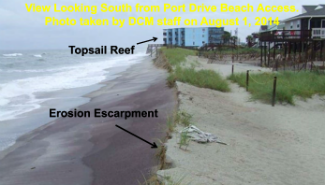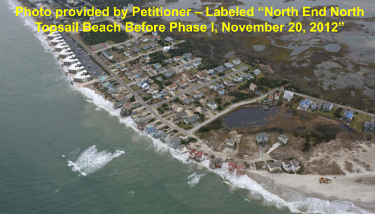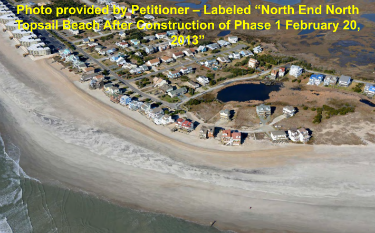 The photo shows the section of the beach at North Topsail Beach that will be armored with a 20-foot-high sandbag wall. Photo: NCDCM |
WILMINGTON – North Topsail Beach has been given the green light to extend a massive sandbag revetment at the northern end of town where severe beach erosion is threatening several homes.
The N.C. Coastal Resources Commission, or CRC, in a special meeting yesterday afternoon unanimously approved a variance to the town’s Coastal Area Management Act, or CAMA, major permit. The variance gives the town permission to build a “super-sized” wall of sandbags substantially larger than the commission’s rules usually allow.
Supporter Spotlight
The wall of bags will span 40 to 45 feet wide and 20 feet tall and extend 1,450 feet from an existing sandbag structure in front of a condominium complex.
“That’s basically the same size structure within a couple of feet here or there of the sandbags that went in two years ago in front of buildings one through five of Topsail Reef Condos,” said Doug Huggett, manager of the N.C. Division of Coastal Management’s Major Permits and Federal Consistency Unit. “This is kind of a continuation.”
Coastal management officials initially planned to deny the first CAMA Major permit application the town submitted in mid-August to install bags larger than what the CRC rule’s on temporary erosion control structures allow.
After some discussion, the town sent a “final design” to the state and a new CAMA major permit application was filed in early October. The division in late October issued a CAMA emergency major permit on the condition the town comply with the CRC’s rule that sandbag structures have a base width of no more than 20 feet and a height of six feet.
As an encroaching ocean caused by what engineers call a “flood channel” in New River Inlet threatened homes collectively valued at about $9 million, town leaders earlier this month applied for a variance requesting the larger revetment.
Supporter Spotlight
The Division of Coastal Management agreed that the larger structure was needed, stating in its stipulation of factthat the CRC’s 6-foot by 20-foot rule is typically sufficient to protect buildings but “in this area, this size may not be sufficient to protect these structures until the predicted channel alignment changes have occurred.”
“Staff believes that due to the proximity of the structures to the ocean in combination with erosion experienced in this area, the public’s access in front of these properties is already limited,” the stipulation of fact reads. “Thus, increasing the waterward footprint of the sandbags proposed from what the Emergency Permit currently allows should not have significant additional impacts on the public’s access to the beach.”
 A close-up of the beach that will be armored. Photo: NCDCM |
The commission’s decision is welcomed news to property owners of the 20 homes where the sandbag wall will be erected.
“It’s going to be ugly, but it’s the only hope we have,” said Cinda Sullivan. “I love my house. I want to keep my house. If those houses go pretty much the whole tip of the island goes.”
Sullivan owns one of the north end homes whose foundations are licked by Atlantic waves even before the high tide moves in and covers the beach.
She and other property owners urged the North Topsail Beach Board of Aldermen earlier this month to move swiftly on requesting the variance.
John Matthews, one of the property owners at that Nov. 6 public hearing, asked the town’s mayor to declare a state of emergency. Matthews said he had already lost 16 inches of sand under his home’s footing.
“I don’t think we have time to wait,” he said. “Every indication is the sand is not there.”
Mayor Dan Tuman declined the request to call for a state of emergency, saying such an action would not expedite the variance process.
In an effort to move as quickly as possible the town board scheduled a special meeting last night to receive recommendations on a contractor for the project. A decision had not been reached by press time.
“The only condition the commission put on it was a timing issue that they agree to do the project within six months,” said Michele Walker, a spokeswoman with the N.C. Department of Environment and Natural Resources.
Town leaders hope the project will be completed in the coming weeks before nor’easter season.
Half of the estimated $2.3 million project will be paid for through a special fee assessed to 39 parcel owners based on oceanfront frontage.
North Topsail Beach has faced an ongoing struggle to keep sand at the north end of the town where Topsail Island’s northern tip meets the inlet.
 |
 The photos show the beach before and after a sand-pumping project last year. Photos: NCDCM |
Erosion of the shoreline south of the inlet has been a persistent problem since 1984, the year the inlet’s bar channel shifted toward an alignment with Onslow Beach.
The shift equated to an all-out assault on north end properties, which are located in all three categories of the state-designated Ocean Hazard Area of Concern, including Ocean Erodible, High Hazard Flood and Inlet Hazard Areas of Environmental Concerns.
Topsail Reef Condos, a series of eight buildings overlooking the Atlantic on the north end, first obtained a state permit in 2012 and again earlier this year to install a sandbag revetment larger than the maximum the CRC typically allows. The bags may remain there for up to eight years.
The nearly two-dozen homes the town hopes to help save were once second row from the beach. An average erosion rate of 5.3 feet a year at the north end ultimately took out the first row of 11 homes.
Those homes succumbed to the rapid erosion despite attempts, including emergency installation of sand bags, to save them.
To combat the problem, town leaders incorporated a channel realignment project into the town’s shoreline and inlet management plan. The first phase of that project, which included re-nourishing the north end, was completed in early 2013.
Property owners fighting to save their homes and town leaders had no idea then that they’d be faced with today’s dilemma.
“All these predictions, these models, that’s just what they are,” said Mike Giles, a coastal advocate with the N.C. Coastal Federation. “These engineers can’t predict this volatile ocean system.”
Giles said that while he is sympathetic to the homeowners of North Topsail Beach struggling to save their houses, their situation is a harsh lesson coastal developers need to learn.
“The solution is to get out of developing on the tips of these coastal hazard zones,” he said.







